Exploring New Opportunities in China’s Aviation Industry
 By Elizabeth Leclaire
By Elizabeth Leclaire
The rapid development of China’s aviation industry has created new investment opportunities for foreign companies looking to enter the Chinese market. Within the next 20 years, China is predicted to witness ten percent annual growth in demand for air transport (compared to two percent U.S. growth), US$64 billion worth of governmental investment into China’s airport development, and an increase of 4,583 civilian airliners.
The 2008 establishment of China’s first aircraft manufacturing company, Comac (Commercial Aircraft Cooperation of China), marks a turning point in an industry long dominated by American aircraft manufacturing company Boeing and its European counterpart Airbus. According to Marwan Lahoud, the head of Airbus’ strategy and marketing, Comac is expected to rise up as a major competitor against both Boeing and Airbus by 2020. Comac’s development of the 156-174 seat commercial airliner C919 is predicted to stand as the primary competition to the commercial aircrafts Boeing 737 and Airbus A320.
Investment Opportunities in Chinese Aircraft Manufacturing
The existence of a domestic aircraft manufacturing company in China has produced a multitude of new investment opportunities and advantages for foreign companies looking to enter the Chinese aviation market.
Though Comac is owned and controlled by the Chinese government, the PRC has explicitly promoted foreign investment into its manufacturing process. The PRC’s 2015 revision of the Catalogue of Industries for Guiding Foreign Investment broadly expanded the range of approved investment activities of foreign companies into the Chinese aviation industry. Foreign investors are now encouraged to manufacture environmentally conscious small scale aircrafts parts such as aircraft motors or bearings and design new Chinese airports.
Foreign companies such as General Electric, Honeywell, Kidde, and Rockwell Collins have already capitalized upon China’s newly expanded investment opportunities to provide Comac with engines, auxiliary power units, flight simulator tests, and fire and heat protective systems.
In addition to receiving governmental approval, Comac has also enjoyed the preference of Chinese airlines seeking to purchase domestically manufactured planes. Of Comac C919’s 400 orders, 380 have either come from companies that lease Chinese aircrafts or directly from Chinese airline companies. Henan Airlines, Shanghai Airlines, and Xiamen airlines have also already established business relations with Comac and have placed orders for C919 aircrafts for their airlines.
Comac’s environmentally conscious and inexpensive aircrafts have also set them apart from Boeing and Airbus. The C919 is not only 15 percent more fuel efficient than its American and European counterparts, but is also less expensive than a 78-113 million USD Boeing 737 or 88-97 million USD Airbus A320.
![]() RELATED: Investing in China’s Aerospace and Aviation Industry
RELATED: Investing in China’s Aerospace and Aviation Industry
Challenges
This is not to say that investment into Comac aircraft manufacturing comes without challenges. Though the PRC has advocated for increased investment in small niche aircraft manufacturing, foreign investment of complete aircraft production and aircraft ownership remained included on Catalogue of Industries for Guiding Foreign Investment’s 2015 revision list of restrictions. This presents roadblocks for investors looking to own Chinese aircraft production companies, as China generally requires a Chinese national as the controlling shareholder of the aircraft company.
Additionally, Chinese produced aircrafts have yet to gain reputable standing within the general public when it comes to safety standards. According to Comac Vice President Luo Ronghuai, the production delay of Comac’s ARJ21 was due its “inability of some key parts to pass flight tests.”
The C919 has yet to be certified by either the American organization FAA (Federal Aviation Administration) or Europe’s EASA (European Aviation Safety Agency). A lack of FAA and EASA certification prevents C919 aircraft flights between Europe and the US. FAA and EASA certification is lengthy, taking Boeing aircrafts approximately 200,000 hours including 4,000 hours of test flights to receive FAA approval. Though lack of FAA status will not restrict Comac from Asian flights, the Chinese aircraft company must obtain FAA and EASA approval to enter the American and European markets and present itself as legitimate competition in the industry.
Investment Opportunities in Chinese Airports
In good news for those looking to invest, foreign investment into China’s aviation industry is not restricted to aircraft manufacturing. As China continues to develop its aviation industry, airport construction has also attracted the attention of the government. China’s 12th five-year plan (2011-2015) for the nation included a focus on aviation development, primarily in terms of improving already existing Chinese airports and building new ones across the nation.
By 2021, China plans to invest US$64 million into 97 Chinese airports. A portion of the funds will be funneled into improving 19 already built airports, and the remaining funds will allow for the construction of 78 new airports.
The need for improvement and increase of Chinese airports has heightened as China has witnessed exponential growth of air travel in the recent years. The Civil Aviation Administration of China (CAAC) has predicted 13 percent annual growth in mainland China’s air traffic. Last year, 86 million passengers passed through Beijing Capital International Airport alone, ranking it as the second busiest airport globally (second to Hartsfield–Jackson Atlanta International Airport). The PRC is currently planning to build another airport in Beijing to mitigate the problem of airport overcrowding.
Additional construction is anticipated for airports in Changsha, Guangzhou, Haikou, Harbin, Lanzhou, Nanjing, Nanning, and Yinchuan, creating a huge range of investment opportunities for foreign companies in the airport design and development industry.
Similar to aircraft manufacturing, the PRC is hesitant to allow foreign companies to serve as the primary owners of Chinese airports. However, provided that a Chinese national is the primary shareholder of the airport company, foreign investment into airport design and construction is encouraged. In fact, the designs of Beijing Capital Airport, Guangzhou’s Baiyun Airport, Shanghai Hongqiao Airport, Shanghai Pudong Airport and Shenzhen Huangtian Airport have all been created by non-Chinese companies.
 RELATED: Pre-Investment and Entry Strategy Advisory from Dezan Shira & Associates
RELATED: Pre-Investment and Entry Strategy Advisory from Dezan Shira & Associates
Concluding Takeaways
Navigating China’s aviation industry is difficult yet rewarding. In both aircraft manufacturing and airport design, the market is relatively open to foreign investment. As China shifts to the foreground of the aviation industry, investor recognition of China as a legitimate competitor in the aviation market becomes increasingly critical.
|
Asia Briefing Ltd. is a subsidiary of Dezan Shira & Associates. Dezan Shira is a specialist foreign direct investment practice, providing corporate establishment, business advisory, tax advisory and compliance, accounting, payroll, due diligence and financial review services to multinationals investing in China, Hong Kong, India, Vietnam, Singapore and the rest of ASEAN. For further information, please email china@dezshira.com or visit www.dezshira.com. Stay up to date with the latest business and investment trends in Asia by subscribing to our complimentary update service featuring news, commentary and regulatory insight. |
![]()
 Adapting Your China WFOE to Service China’s Consumers
Adapting Your China WFOE to Service China’s Consumers
In this issue of China Briefing Magazine, we look at the challenges posed to manufacturers amidst China’s rising labor costs and stricter environmental regulations. Manufacturing WFOEs in China should adapt by expanding their business scope to include distribution and determine suitable supply chain solutions. In this regard, we will take a look at the opportunities in China’s domestic consumer market and forecast the sectors that are set to boom in the coming years.
 Industry Specific Licenses and Certifications in China
Industry Specific Licenses and Certifications in China
In this issue of China Briefing, we provide an overview of the licensing schemes for industrial products; food production, distribution and catering services; and advertising. We also introduce two important types of certification in China: the CCC and the China Energy Label (CEL). This issue will provide you with an understanding of the requirements for selling your products or services in China.
 Doing Business in China
Doing Business in China
The Dezan Shira & Associates Business Guide to Doing Business in China is the definitive guide to one of the fastest growing economies in the world, providing a thorough and in-depth analysis of China, its history, key demographics and overviews of the major cities, provinces and autonomous regions highlighting business opportunities and infrastructure in place in each region.
- Previous Article An Introduction to Doing Business in China 2015 – New Report from Dezan Shira & Associates
- Next Article Le Secteur de l’Édition en Chine: Chemin Semé d’Embûches ou Marché Lucratif?
























